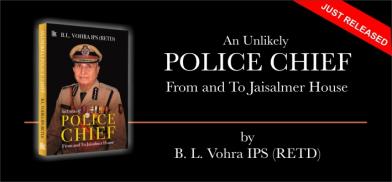How the battle against insurgency was won in Tripura
A mere look at the map of Tripura showed that the insurgents were operating from the hills where there was no police presence as all the police stations and posts were on the main roads. I was convinced that we should move into the hills.

While posted as Director General of Tripura state to tackle insurgency, I was gradually convinced that we would be able to handle the situation. The next big task was to convince the officers and other ranks of the police force. It took time, but slowly, I was able to convince them by exhorting them. Of course, we needed lot of wherewithal to achieve success, which we ultimately arranged.
Slowly, we started achieving success against the insurgents and finally the Tripura Police was able to turn the corner decisively. On this success of counter-insurgency operations led by the Tripura Police, without any help from the Army, I later wrote a book, Tripura’s Bravehearts, a copy of which I also presented to the then Prime Minister Manmohan Singh who lauded the work of the state police.
I will briefly mention the steps taken in our fightback. A mere look at the map of Tripura showed that the insurgents were operating from the hills where there was no police presence as all the police stations and posts were on the main roads. I was convinced that we should move into the hills. So I called a meeting of all the senior officers and asked them their views. The opinion was divided but I stuck to my decision of moving in.
To my pleasant surprise, CO Joydev Das of the 2nd TSR Battalion, beyond 50 in age, who had risen from ranks, volunteered to open the first camp which he did in Panjirai in the south district. I visited it and stayed overnight also there. However, we needed manpower in a big way to move into the hills. The sanctioned strength of the police was less than required and much of our manpower was concentrated on VIP security duties and in security camps in some villages and areas that had witnessed killings.
More manpower and SPOs
The government sanctioned more manpower to increase the strength of the existing police stations as well as increase the number of police stations and Tripura State Rifles (TSR) battalions. We also got a few India Reserve Battalions raised by the state but funded by the Centre. We began establishing TSR camps in the areas dominated by the insurgents. Even the headquarters of some battalions were relocated in the interiors. We also managed to get four companies of the TSR as peace companies to guard the ongoing projects because we knew that insurgents extorted money from the contractors.
But the biggest success was to persuade the Chief Minister to appoint a large number of Special Police Officers (SPOs) under the Police Act. We appointed a large number of unemployed youth, and those tribal boys who were helping insurgents in the hills, as SPOs with a fixed salary of Rs.1500 per month, gave them some training and .303 Rifles. We established many camps with a strength ranging from 10–30 of these personnel with a regular police Havildar or so as the in-charge of the camp. Additionally, the functioning of the Home Guards was revitalized by weeding out the dead wood and replacing it with young blood. Two newly raised TSR battalions were also trained in counterinsurgency operations in the army’s Counter Insurgency and Jungle Warfare School at Vairengte in Mizoram.
Later, we opened our own training school in Dhalai district for this purpose. Accommodation, training, weapons, transport, communications and other logistics were arranged on a war footing. For accommodation, we established semi-pucca iron structures which were more durable than the normal bamboo bashas (structures). In no time, we managed contact with the insurgents at many places as they were taken by surprise. Increased intelligence and cooperation from the people in the hills and elsewhere bolstered our success, supported by the bureaucracy, politicians and the media. Our intelligence unit revitalized itself, including launching psychological warfare against the insurgents.
Winning the battle
The extensive touring that I undertook in the jungles on foot with other officers raised the morale of the forces. Once I walked for about 30 kilometers through the jungles and difficult mountain terrain to visit one of the remote TSR camps in the hills. I visited each police station, sometimes by surprise, and gave them all the resources needed to fight the situation. They also knew that they would be held accountable. The communications system was revitalized by connecting all police stations with a wireless set-up in each moving VIP, filling the gaps that existed earlier.
The Central government also chipped in. We got some money and weapons, transport, other equipment under the modernization grant. Surrender-cum-Rehabilitation schemes were launched and operated, with the result that quite a few surrenders took place. A camp for those who gave up arms was established to stay there safely or learn skills that would help them join the mainstream.
So the battle was on. The ambushes, the encounters, the attacks went on, but slowly, the violence graph came down.
(The author is a former Indian Police Service officer. Excerpted from his book An Unlikely Police Chief: From and To Jaisalmer House/Konark Publishers)
Reading through this article reminds me of my previous roommate!
He constantly kept preaching about this. I am going to send this post to him.
Fairly certain he will have a great read. I appreciate you for sharing!
a amusement account it. Glance complicated to far added agreeable from you!
However, how could we be in contact?









Post a Comment